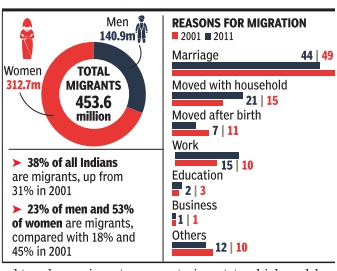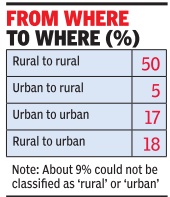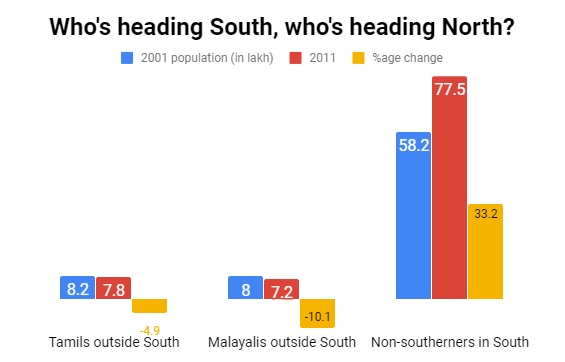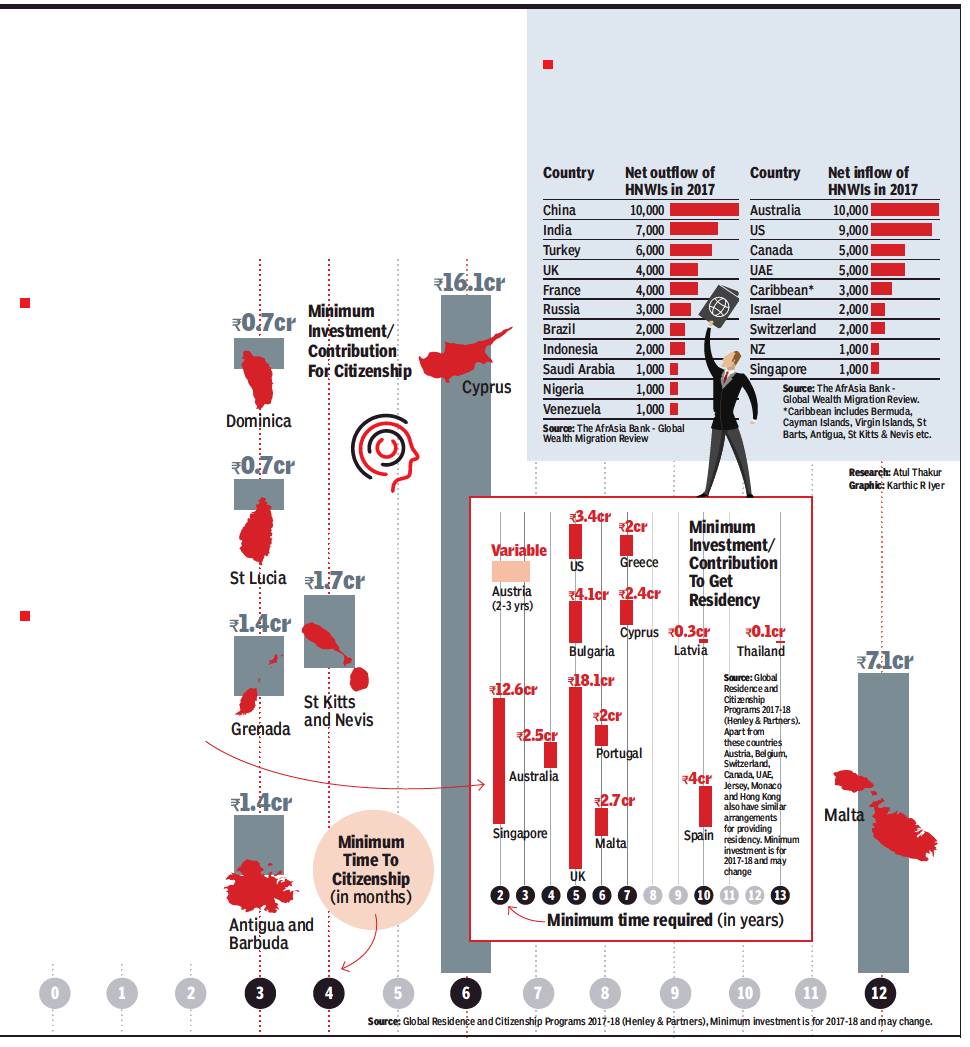Migration: India
This is a collection of articles archived for the excellence of their content. |
Contents[hide] |
Internal migration
40% Indians migrants; mainly for marriage
Subodh Varma, 4 of 10 Indians migrants, most move for marriage, Dec 2, 2016: The Times of India


Nearly two out of five Indians -some 454 mil lion in all -are migrants, having left their place of residence and settled down somewhere else, according to fresh Census 2011 data on migration released on Thursday . Between 2001 and 2011, 139 million Indians migrated within the country . The vast majority of migrants, 69%, are women moving out of their parental homes to stay with their husbands in their native homes, or perhaps migrate with them elsewhere.
Half of this massive movement of humanity is taking place within rural areas -rural-to-rural migration.Rural-to-urban migration makes up about 18% while urban-to-urban is another 17%. In 2001, the share of ru ral-to-urban migrants was about 17%, indicating that there has not been a big shift in the percentage of people moving from villages to cities during the 2001-2011decade over the 1991-2001decade.
This complements the earlier data given by the census that the urban growth ra te is not too high and has slackened in many cities.
Among the reasons cited for migration by those surveyed, about 10% moved in search of employment during the decade ending 2011, down from 15% in 2001. This is counterintuiti ve, considering the po pular belief that mig ration is primarily driven by work.The share of those moving to pursue education makes up only 2% of migrants, down from 3% recorded in the 2001 census.
Marria ge remains the biggest cause for migration, accounting for 49%, up from 44% in 2001. The census questionnaire includes a reason de signated as “moved after birth“, which is mainly children being born in a pla ce -the mothers' village or a nearby town with hospital -and then moving back home to the parental ho use. This share has in 7% creased from in 2001 to 11%More in 2011.
than a fifth of all migrants had said in 2001 that the reason for migrating was that their fa mily was moving. They wo uld be dependents, both yo ung and old. This share has declined to 15% in 2011.
Talent from north heads south
Recruitment agencies are facing a new challenge: While there are more job opportunities in the south thanks to a surge in startups, e-commerce and retail firms, the talent is in the north.
The south accounts for close to 40% of Randstad India’s recruitment for its clients, followed by the west at 28%, north at 25% and the east at 7%. For TeamLease Services, 40% of overall job positions are for the south. The figure would touch 70% if south and west are combined. Rituparna Chakraborty, co-founder, TeamLease Services, said: “People follow jobs and move where there is surplus demand for talent. At this point, that’s from north to south.”
Tally Solutions, a Bengaluru-based company that offers business management software solutions, has been recruiting from north India. Kankana Barua, chief people officer at Tally Solutions, said: “Companies facing a crunch in talent above mid-levels are looking for talent across India, especially from the north.”
The old reluctance to move to a city with a different language and cuisine is also eroding. Barua said that if a company provides good growth opportunities, people are ready to relocate. The influx of people from different regions to Hyderabad, Bengaluru and Chennai is creating cultural diversity. “I now see people conversing in Hindi in Chennai, for instance,” said Barua.
3 South IT hubs account for 60% of workforce
The south is home to three of India’s seven largest urban centres and accounts for more than half the total jobs created in the formal sector. The emergence of the IT industry as the single largest employer of graduates has played a significant role.
The three southern IT hubs of Chennai, Hyderabad and Bangalore account for more than 60% of the workforce employed by the sector, as per industry estimates. Chennai and Hyderabad are hubs for manufacturing and infrastructure too.
Paul Dupuis, MD and CEO, Randstad India, said: “The south will continue to lead the way in job creation, specifically in IT and related roles, given the headstart the region has in terms of the number of companies, presence of a qualified talent pool, quality educational institutions, and relative proximity of the three major urban centres.”
Naresh Rajendran, HR head, Grundfos India, which is headquartered in Chennai, said the company does not find it hard to hire talent willing to move to the south. He added that there is a trend of knowledge and blue-collar talent moving from other regions to the south, for IT, automotive, retail, e-commerce and infrastructure jobs.
Hindi, Bengali, Odia speakers surge in South India/ 2011
Rema Nagarajan, June 28, 2018: The Times of India

Migration of non- southerners to south India.
From: Rema Nagarajan, June 28, 2018: The Times of India
HIGHLIGHTS
Just-released data from the 2011 census on mother tongues seems to indicate a reverse migration trend from earlier decades
Maharashtra, once a favoured destination for south Indians, mostly because of Mumbai, witnessed a decline in Kannada, Telugu, Tamil and Malayalam speakers
Tamil and speaking populations are falling across most states in north India even as and Kerala are seeing a huge jump in the number of Hindi, Bengali, Assamese and Odia speakers. Just-released data from the 2011 census on mother tongues seems to indicate a reverse migration trend from earlier decades when people from the two southern states migrated in large numbers to the north.
Instead, a large number of people from the two states are now migrating within the south, with Karnataka seeing a significant influx. Delhi saw a fall in numbers of both Tamil and Malyali speakers between the 2001 and 2011 censuses.
Maharashtra, once a favoured destination for south Indians, mostly because of Mumbai, witnessed a decline in Kannada, Telugu, Tamil and Malayalam speakers. In the north, the highest growth in Malayali population between the 2001 and 2011 censuses was in Uttar Pradesh, perhaps because of Noida, while that of the Tamilian population was in Haryana, which might be because of Gurgaon.
But the absolute numbers involved are small compared with the migration of Tamilians and Malayalis within south India. While Tamil Nadu and Kerala saw the highest growth in Hindi speakers among all states, all of south India is witnessing a steady increase, with the highest absolute number of Hindi speakers in the region being in Karnataka and Andhra Pradesh.
Kerala also saw the highest growth in Assamese and Bengalis even if the absolute numbers were not as high as in Maharashtra or Karnataka. The number of Nepali speakers too is growing fast in the south.In both cases, there is a growth of about 24% in populations speaking the respective languages.
HNW individuals’ migration
How The Rich Buy New Nationalities; 2017 figures
How The Rich Buy A New Nationality, July 30, 2018: The Times of India

ii) THE countries that they migrate to.
From: How The Rich Buy A New Nationality, July 30, 2018: The Times of India
Fugitive Mehul Choksi bought Antiguan citizenship, and his new passport allows him visa-free entry to over 130 countries. TOI takes a look at how the rich can buy their way to new citizenship and residency
Can citizenship be acquired by investing?
Acquiring citizenship need not be a long-drawn process. Not all nations need you to prove years of residency. Many countries offer the wealthy citizenship-by-investment programmes. This method of granting citizenship was seen as controversial when Caribbean island St Kitts and Nevis pioneered the idea in 1984. But today many countries have followed suit to offer citizenship to well-heeled individuals who donate a fixed amount to the government of their new home or invest over a certain level.
Can permanent residency be acquired by investing?
Many countries that don’t provide citizenship but grant residency to the wealthy if they invest above a certain amount in the local economy. Residency provides unlimited stay and rights enjoyed by locals. These may include benefits like healthcare coverage and the right to work or study. Such residents cannot vote and are not issued passports of their new home nation. Indians, for instance, can apply for Tier 1 (Investor) visa of UK if they are willing to invest GBP 2 million (INR 18.1 cr). Similarly, the process for a US Green Card can be expedited for an individual who invests USD 1 million (or USD 500,000 in rural areas with few jobs) and creates at least 10 new full-time jobs.
Where are the super-rich going and which countries are the biggest losers?
South Africa-based New World Wealth, a global market research group that specialises in wealth statistics, found China followed by India witnessed the highest migration of high net worth individuals (HNWIs) — people with net assets of US$1 million (Rs 6.9cr) or more. The largest recipient of these super rich migrants are Australia, US and Canada.
Women migrating abroad
2010
Changing times: More women go abroad to work
Divya A |
June 2010
Deepa Gupta, 22, a mathematics graduate from Ludhiana, thought it a great opportunity to go to a postgraduate course in Michigan University. Two years down the line, she is settled in the US and has been joined by her widowed mother.
Gupta represents a trend — that of Indian women increasingly leaving home turf for professional, rather than personal reasons. The World Bank’s report on ‘Gender, Poverty Reduction and Migration’ says more women from developing countries such as India are migrating to the West independently rather than as dependents. It also says that female migration indirectly helps alleviate poverty.
Neelam Soni, executive with an overseas placement agency in Delhi says women in nursing, teaching, social and voluntary work, the hospitality industry, data-entry operations, sales and even housework are able to migrate to foreign shores.
Social scientist Mala Kapur Shankardass says that even though a large proportion of female migration can still be explained away by marriage (estimates say 80%) it is significant that 20% of all women migrants leave for professional reasons. A decade ago, less than 5% of women migrants worked She says that earlier, male migrants used to belong to the ‘Employed’ category and female to the ‘Not in the Labour Force’. This is changing. Shankardass.
But Shankardass cautions that Indian female contribution to forex remittances is still not properly documented. Official data largely focuses on male remittances.
See also
Migration: India